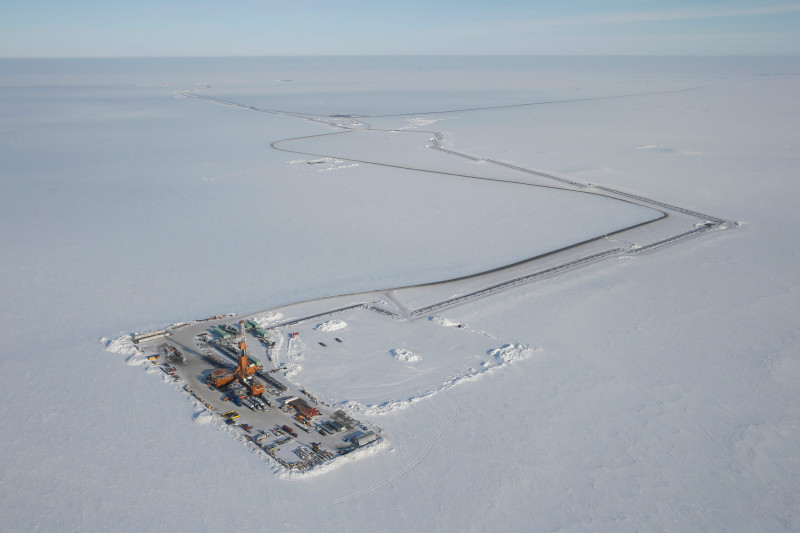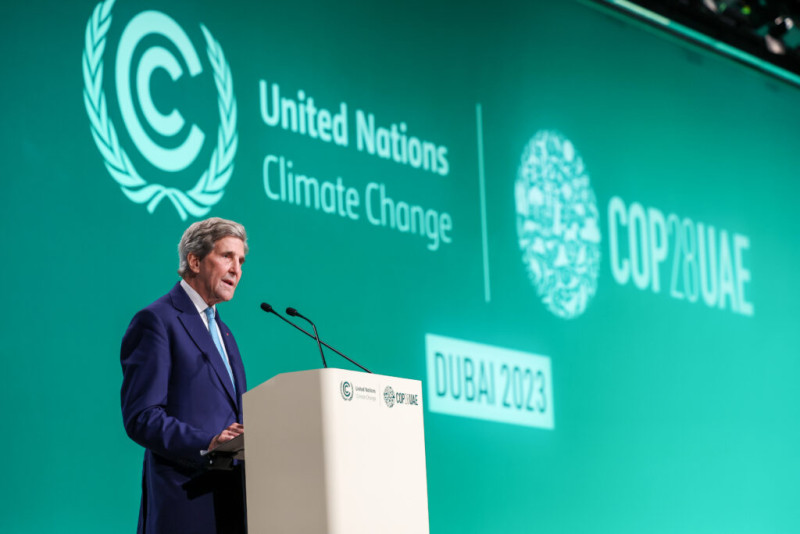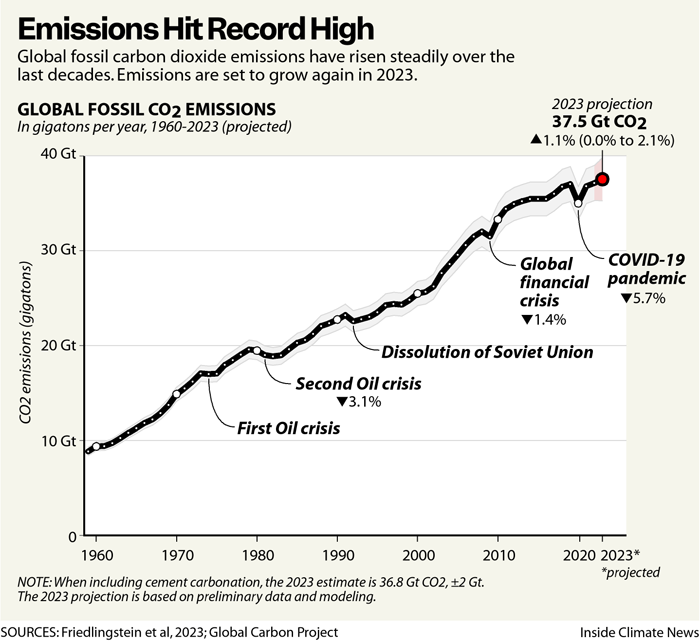2023 in Climate News
In 2023, clean energy progress and the horrors of a radically warming climate fought almost to a draw.
The rise of solar power, battery storage and electric transportation helped to inspire optimism about humanity’s ability to preserve a recognizable world. But the year also revealed how much damage to the climate has been done and may be locked in, and how the pain will disproportionately be felt by some of the people with the least resources.
“This year was the year of tipping points, both positive and negative,” said Katharine Hayhoe, an atmospheric scientist, writer, and commentator who teaches at Texas Tech.
“We’re starting to realize how urgent this is and how relevant it is to all of us,” she said of the need to address climate change. “But we’re also seeing the solutions coming up so quickly that all the projections are always underestimating the growth of solutions.”
It is almost impossible to determine whether progress is keeping up with the losses. The answer depends in part on what happens in 2024, with policy decisions, elections and the ongoing march of research that may—or may not—build on gains of this year.
What follows is a digest of some of the year’s key climate and clean energy actions.
WINTER
The year began with temperature and weather extremes, a string of investment announcements tied to the Inflation Reduction Act and a leap forward for Minnesota climate policy.
Pretty Much the Opposite of Dry January: 2023 began with an ominous warning sign, the unprecedented meltdown of Antarctic sea ice, which could signify that parts of Earth’s climate system have already passed tipping points. Sea ice buttresses Antarctica’s land-based ice sheets, and other studies showed that, in past geologic eras, the ice sheets have retreated in pulses of up to 2,000 feet per day, which could result in much more rapid sea level rise than projected by most climate models.
We Wanted Rain, But Not Like This: Bizarre winter weather, brought on by climate change, battered the U.S. this year. Californians learned firsthand what scientists mean by “climate whiplash.” Atmospheric rivers, also known as “rivers in the sky,” dumped biblical amounts of rain onto a parched state plagued by years of record-breaking drought. Later in the winter, a polar vortex—brought on by the Arctic warming four times faster than the rest of the world and destabilizing the jet stream—prompted flight cancellations, trapped snowbound drivers on highways and left millions of Americans temporarily without power.

The IRA Is Like Christmas All Year for Economic Development: On Jan. 11, Hanwha Q CELLS said it was making a $2.5 billion investment to expand its solar panel manufacturing capacity in Georgia. The South Korean company’s announcement was one of many examples of manufacturers of clean energy components spending heavily in the United States to benefit from the Inflation Reduction Act. The IRA, signed in August 2022, is the largest climate and clean energy legislation in the country’s history; in addition to manufacturing incentives, it contains the federal government’s largest single investment in environmental justice efforts. Throughout 2023, it gave governors, mayors and other officials the opportunity to tout economic development victories, often without mentioning the role of the Biden administration’s signature law.
Minnesota, Nice: Minnesota Democrats gained control of their legislature in the 2022 election and moved quickly to pass a far-reaching clean energy law when the new session began. Gov. Tim Walz, also a Democrat, signed Senate File 4 in February, requiring the state to obtain all of its electricity from clean sources by 2040. Minnesota became part of a group of 11 states, Puerto Rico and Washington, D.C. that have laws setting out a path to 100 percent clean energy, with varying definitions of what constitutes clean energy. Michigan would join in November to bring the number to a dozen.
The EPA Goes to Work: A burst of proposed rules from the Environmental Protection Agency sought to rein in health threats from air pollution and limit greenhouse gas emissions from vehicles and power plants. Starting in January, the agency sought to tighten standards for PM2.5, the small particulate matter generated by fossil fuel and wood combustion that is linked to heart and lung ailments and a range of other health harms. Other actions followed later in the year.
Stepping Forward and Back on Public Lands: The Biden administration took major steps to protect and expand public lands in 2023. But it also approved, in March, the largest new oil project in the Arctic in years—ConocoPhillips’ $8 billion Willow project in Alaska’s National Petroleum Reserve. The project had become an important symbol to environmentalists and the oil industry alike, as well as a cause for politicians in Alaska, a state deeply dependent on oil revenue. Around the time the Willow decision was announced, the Biden administration rolled out stronger and expanded protections across 16 million acres of the Alaskan Arctic, including the entire U.S. Arctic Ocean. The administration later withdrew all leases for drilling that President Donald Trump’s administration approved in the Arctic National Wildlife Refuge. In January, it reinstated bans on logging and road-building across 9 million acres of Tongass National Forest, a pristine old-growth ecosystem that is habitat for 400 species and is considered critical carbon storage to help mitigate climate change. Biden also established three new national monuments on important landscapes for tribal nations and Indigenous peoples. Avi Kwa Ame, also known as Spirit Mountain, spans 500,000 acres in Nevada that are considered among the most sacred places on Earth by three tribes of Indigenous peoples; Castner Range in El Paso is a former Army artillery site that contains significant cultural sites documenting the history of tribal nations; and the Baaj Nwaavjo I’tah Kukveni National Monument protects 1 million acres surrounding the Grand Canyon that contain thousands of sacred and culturally significant sites.

No Russian Gas, No Problem: The war in Ukraine led to a major reduction of natural gas supplies in much of Europe and questions about how the European Union would find enough energy to fuel its economy. But by early 2023, it became clear that a mild winter along with energy conservation and a rising use of alternative sources allowed the EU to get through the coldest days of winter. Germany, for example, managed to avoid the very real risk of “a meltdown,” according to Robert Habeck, the country’s climate and environment minister. One of the larger lessons was that governments are capable of making large changes to their energy sources in a crisis.
SPRING
The push and pull almost felt like whiplash in the spring. The Biden Administration took big steps to clean up the environment through EPA rulemaking. At the same time, the Supreme Court issued a decision limiting federal authority on clean water and U.S. natural gas production reached new heights.
The EPA Does Some Heavy Lifting: In April, the EPA proposed the first update in 20 years to rules limiting toxic air pollutants such as benzene from chemical and plastics plants. The new rules seek to address the disproportionate health risks faced by people of color who live near polluting facilities, like those in so-called “Cancer Alley” along the Gulf Coast in Louisiana and Texas, a step that residents have been seeking for years. That same month, the EPA proposed rules on greenhouse gas emissions from passenger vehicles, anticipating and encouraging a major shift to EVs. In May, the EPA followed with a long-awaited plan for tackling power plant carbon pollution that would require most big polluters who anticipate staying open past 2032 to install expensive carbon capture and storage technologies presently not in use at scale. Analysts say the rule would result in an 82 percent reduction in greenhouse gas emissions from the power sector by 2040.

Supremes Take a Wrecking Ball to the Clean Water Act: In the most important regulatory lawsuit of the year, the U.S. Supreme Court in May sharply limited the EPA’s authority to protect wetlands. Taking the kind of narrow reading of the law that has become characteristic of the post-Trump court, the justices ruled that the Clean Water Act gave the EPA authority over only pollution in “navigable waters,” not in wetlands that become a conduit for pollution and runoff into those rivers and lakes during heavy rains or flooding.
That’s a Lot of Gas: U.S. natural gas production, which has been consistently higher under President Joe Biden’s administration than during the Trump years, hit two monthly records this year before reaching an all-time high of 3.9 billion cubic feet in May, according to the U.S. Energy Information Administration. Oil production hit an all-time high in August.
For Nuclear Power, Even the Good News Was a Bit Bad: On May 29, Georgia Power announced that Plant Vogtle Unit 3 had reached 100 percent energy output for the first time, an important step toward the nuclear plant going online two months later. But years of delays and billions of dollars in cost overruns meant that Vogtle had already done serious damage to the idea of a nuclear renaissance in the United States. Nuclear power advocates are now focusing their attention on small modular reactors, which they hope will avoid the perils of gigantic projects like the 1,100-megawatt Unit 3. And yet, this next generation of technology has its own long timelines and cost concerns, as indicated by the cancellation later in the year of the NuScale small modular reactor project in Idaho.
SUMMER
As summer arrived, it became clear that the consequences of climate change are in our present, not our future. But the swift deployment of clean energy technologies provided some hope.
Summer in Hell: The southern U.S. and many parts of the world endured months of extraordinarily high temperatures. Phoenix shattered its previous heat record with 31 days straight of temperatures over 110 degrees. The city confirmed 579 heat-related deaths, many of which came from the city’s unhoused population. Beijing set a new record for high-temperature days, which led to outdoor work being halted during the hottest parts of the day. The record-setting heatwaves, researchers found, would have been “almost impossible” without human-caused warming. The extreme heat was impossible to ignore, affecting infrastructure, jobs and lives. June was the hottest June on record, and then July broke the monthly record, too. Then August did the same. So did September. And October. And November.

Further Flooding: Heat wasn’t the only dangerous weather conditions to break records this summer. Heavy rainfall and flash floods devastated communities worldwide, from the U.S. to Libya, to nations all across Asia and Europe. It was especially catastrophic in India and Libya, some of the poorest countries to suffer major losses. In India, hundreds died between June and the end of September due to flooding and heat, while more than 11,000 people died in Libya in September following floods that caused two dams to collapse.
In Hot Water: In Florida, the extreme heat prompted record water temperatures—as high as 101.1 degrees—that were catastrophic for delicate corals, including those protected as part of the Florida Keys National Marine Sanctuary, which incorporates the only barrier reef in the continental United States. The damage sparked a rush to rescue ailing corals and relocate them to on-land tanks, where they could be preserved. Warm waters also propelled an unprecedented hurricane season that shattered several records. At the season’s height, between the end of August and the end of September, a record 13 named storms formed, breaking the previous record established in 2020.
Things began to look very unusual two months ago.
— Dr Thomas Smith 🔥🌏 (@DrTELS) June 10, 2023
Today the charts need no commentary, they speak for themselves.
This is the Atlantic. https://t.co/P26XnJmKj6 pic.twitter.com/Xin8kUT3Fr
Difficult Times on the Border: Deaths of migrants on the U.S./Mexico border increased during one of the hottest summers on record. More than 100 deaths were reported in the El Paso sector of the border during the summer months. Forty-two deaths were reported along the border in Arizona during August alone. The U.S./Mexico border is now the world’s deadliest land migration route.
Smoke and Mosquitoes: Smoke from massive Canadian wildfires blanketed much of the eastern half of the United States this summer, spurring a conversation about public health and air quality. The season’s record heat also came into the conversation after eight people in the U.S. contracted malaria from local mosquitoes—the nation’s first such cases in 20 years. As climate change plays out, researchers say, warmer and wetter weather could mean more mosquito-borne illnesses.

Some Good News Amid All the Bad: Global growth of clean energy continued throughout 2023, with solar, battery storage and heat pumps among the technologies that made substantial progress. But is the growth fast enough? The International Energy Agency gave a nuanced answer in a July 12 report. The agency found that the growth of solar power is happening fast enough to align with the goal of reaching net-zero emissions, and the production of EV batteries is happening at a rapid enough pace to meet projected 2030 demand. China, while continuing to rapidly open new coal-fired power plants, also accounts for a disproportionately large share of clean energy development, with the country projected to add a record high 230 gigawatts of wind and solar capacity this year, according to Wood MacKenzie. That’s about twice what’s generated by installations in the United States and Europe combined.
FALL
We don’t yet know what aspects of 2023 will turn out to be significant in the sweep of the world’s efforts on climate and clean energy. What we can say is that fall was unusually eventful for climate policy and law, and the rise of clean energy technologies.
Reasons to Cheer (and Cringe) at COP28: The annual U.N. climate summit, known as the Conference of Parties, often is a punctuation mark on the year in climate, so all eyes were on Dubai in early December, where more than 190 countries finally put down in writing that the world needs to transition away from fossil fuels in energy systems. Most scientists said this action comes much too late to prevent additional catastrophic climate heating, while acknowledging that naming the problem does signify some progress. But, long before it started, COP28 was marked by controversy for being held in a petrostate and presided over by the head of one of the world’s largest oil companies: In a separate event a few weeks before the talks began, COP28 president Sultan al-Jaber falsely stated there is no science showing that phasing out fossil fuels is necessary to achieve the Paris Agreement goal of limiting global warming to 1.5 degrees Celsius above the pre-industrial baseline.

Damage Control: The Loss and Damage Fund received more than $700 million in pledges from developed nations, exceeding the expectations of many observers. Unfortunately, that falls far short of the more than $300 billion the U.N. says is needed every year through 2030 to ensure poor countries can adapt to climate change.
Inching Toward a Global Approach to Methane: 2023 brought new, more stringent methane regulations for the oil and gas sector in the U.S.—the world’s largest producer—and for gas imports to the EU—the largest consumer. Meanwhile, a deal brokered between the U.S. and China in the lead up to COP, and later included in the final COP agreement reached in Dubai, pledged to slash methane emissions by 2030. Taken together, the efforts could be the beginning of a binding international agreement to phase down emissions of the second leading driver of climate change.
Food Fights: Two notable, but voluntary, food-related pledges emerged from COP28, including a “roadmap” from the U.N., intended to guide countries in reducing food-related emissions and a “Declaration on Sustainable Agriculture, Resilient Food Systems and Climate Change,” onto which more than 150 countries signed. Advocacy groups celebrated the focus on agriculture, but were disappointed that there were no specific emissions reductions targets in the pledges. Now, in the United States, they’re turning their attention to the Farm Bill, the sprawling legislation that covers food and farm policy. The bill expired this year, but was extended to September of 2024. The food system, from farm to fork to trash bin, accounts for about one-third of all greenhouse gas emissions, much of it methane.
Nov. 17, 2023: This was the first day the global temperature was 2 degrees warmer than pre-industrial levels, according to the European Centre for Medium-Range Weather Forecasts’ analysis.
EV Sales Soar, But with Caveats: U.S. sales of electric vehicles hit 1 million for the year in November, the first time they had reached that level, as market share rose to near 10 percent. Global EV sales also soared, with the market share leader, Norway, getting 90 percent of its new car sales from EVs. But the growth of EV production has also led to concerns at some automakers that certain models are not profitable and are sitting for too long on dealer lots.

Hints of Breakthrough in International Climate Law: In September, a historic court case with consequential implications for global climate action got underway before the International Tribunal for the Law of the Sea. The case is the first time an international court will address questions of whether greenhouse gas emissions constitute oceanic pollution, and if so, what governments must do about it. The court’s advisory opinion on those issues will set a crucial precedent for future climate litigation, including two other pending climate change cases before the International Court of Justice and the Inter-American Court of Human Rights. Notably, the Law of the Sea hearings revealed that the majority of nations (China and India were exceptions) agree with the scientific consensus that greenhouse gases pollute the oceans through acidification, heating and other impacts. There was less agreement on what governments’ must do about the problem. The court is expected to issue a ruling early next year.
DoD Dodges: The National Defense Authorization Act, passed on Dec. 19, says little about climate change and national security. “There is a significant provision to prohibit required disclosure by the U.S. Department of Defense contractors of information relating to greenhouse gas emissions,” said Tamara Lorincz, a researcher with Balsillie School of International Affairs. The bill also sunsets the U.S. Climate Security Advisory Council at the end of 2025. This is the latest in a long-running list of obstacles that prevent the disclosure of militaries’ fossil fuel consumption and global emissions from international accounting protocols and agreements. U.N. Secretary-General Antonio Guterres has called for “no exceptions” and “no compromises” at COP28 given the staggering ecological cost of wars. The first year of the war in Ukraine alone is estimated to have belched out a net increase of 120 million tons of greenhouse gases, equal to the annual output of Singapore, Switzerland and Syria.
U.S. Climate Assessment Is Grim Reading: This year, the federal government released the Fifth National Climate Assessment, its preeminent report on climate change impacts, risks and responses. Its conclusion: As the impacts of climate change worsen, no part of the country will be spared. Ignoring those risks has ever-increasing costs, the report said. In the 1980s, the country experienced, on average, one billion-dollar disaster every four months, according to the NCA. Now, there is one every three weeks, on average.
Fossil Fuel Fervency: In the same year that nations of the world agreed to transition away from fossil fuels, carbon dioxide emissions were projected to climb to about 37.5 billion metric tons in 2023, a record high, according to data collected by the Global Carbon Budget. Increased fossil fuel use this year was driven by growth in China, India and from international shipping and aviation. Fossil fuel burning declined in most of the rest of the world.

What Lies Ahead: One of the most discouraging possibilities for people who work in clean energy is that the progress of this year could be undone next year, at least in part, depending on the results of the U.S. presidential election. President Biden has put climate change and clean energy at the forefront of his agenda to a greater extent than any of his predecessors. But he faces a bruising campaign for re-election. His most likely opponent, former president Donald Trump, signaled what he would do on energy policy with his comments on Dec. 11 to the New York Republican Club, declaring that he would be a “dictator for one day.” He said he would do this “because I want a wall” on the southern border and “I want to drill, drill, drill” for oil and gas.
Optimism Versus Pessimism: Climate and clean energy advocates are spending the final days of the year trying to make sense of what they just experienced. Sonia Aggarwal, the CEO of the think tank Energy Innovation and a former climate adviser to the Biden administration, acknowledges there were plenty of reasons to be pessimistic in light of rising temperatures and the challenges to finding consensus on climate policies. But she thinks progress in the clean energy economy around the globe and across sectors was so great that she leans toward optimism. “Just going sector by sector on the numbers, it’s a pretty compelling story,” she said. “We’ve hit the accelerator on the clean energy path.”
Share this article
Disclaimer: The copyright of this article belongs to the original author. Reposting this article is solely for the purpose of information dissemination and does not constitute any investment advice. If there is any infringement, please contact us immediately. We will make corrections or deletions as necessary. Thank you.







